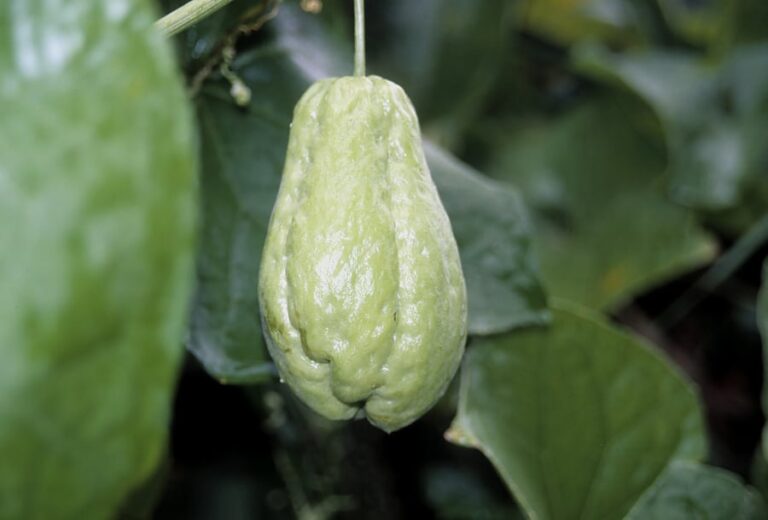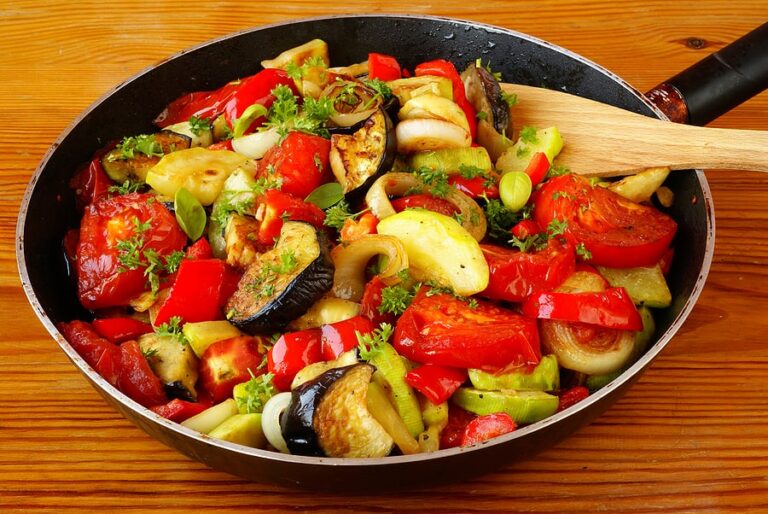How to Cook and Serve Bitter Melon
Bitter melon can be eaten raw when thinly sliced raw but it’s commonly cooked. Bitter melon can be stir-fried, parboiled, or stuffed.
The bitter melon picked at maturity will be bitter. The younger, thinner, shorter, and bright green bitter melon will be less bitter tasting.
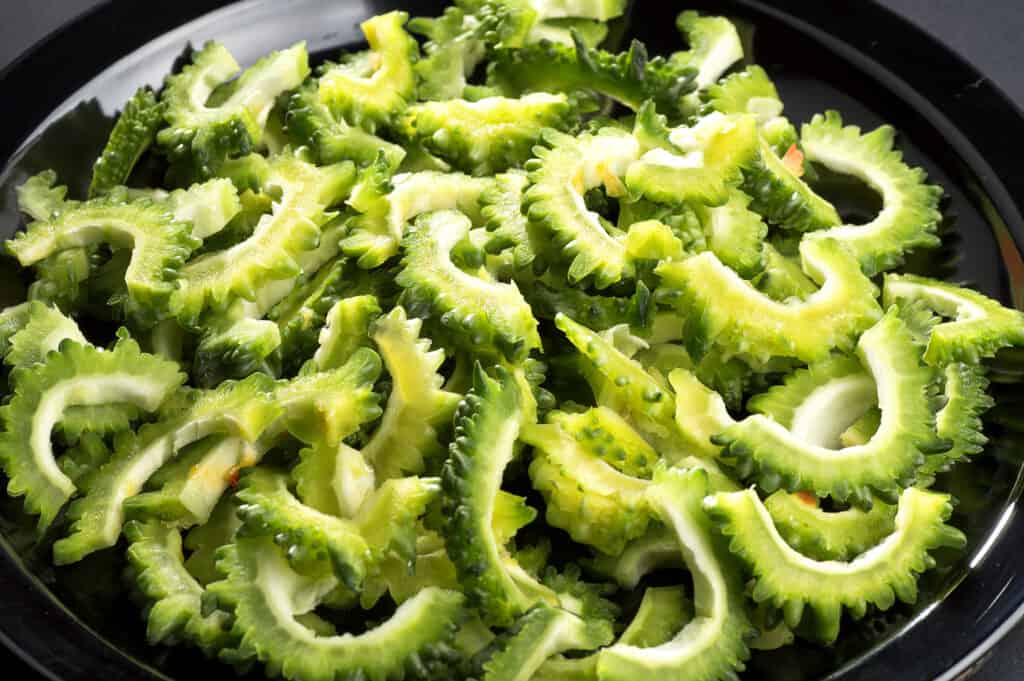
The bitter melon harvest season runs from mid-spring through late summer.
Kitchen Helpers from Amazon:
- Oster Vegetable Steamer
- Chef’s Knives Set of 6
- EZ Off Jar Opener for Weak Hands
- Pepper Core Remover Stainless Steel
- Kitchen Utensils – Set of 35
How to choose bitter melon
- Select bitter melons that are small, bright green, firm, and without blemish or mold.
- Bright dark green specimens will be less bitter tasting.
How to store bitter melon
- Keep the bitter melon wrapped in a paper towel in a perforated plastic bag in the vegetable drawer of the refrigerator for 4 to 5 days.
- Bitter melons do not freeze well.
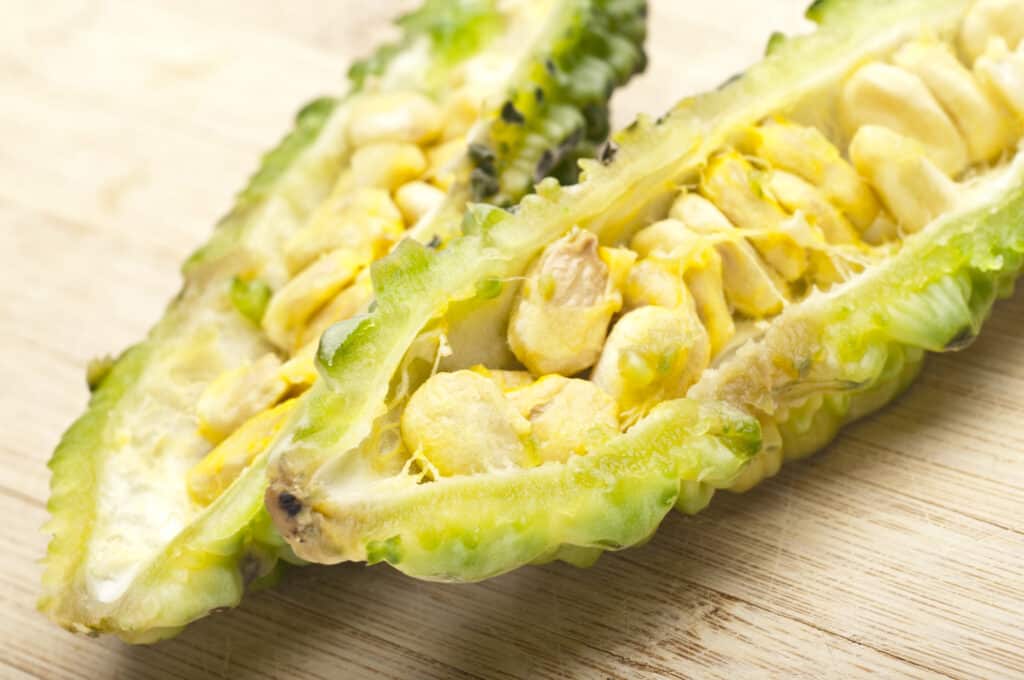
How to prepare bitter melon
- Bitter melon does not need to be peeled if sliced thinly. But you can trim and peel smoothly the bitter melon.
- Seeds can be removed or not; they may bring an additional bitterness to a serving especially as the gourd matures. To remove the seeds, cut the gourd into slices and pop out both seeds and pith with your finger, leaving a green ring, or halve the gourd lengthwise and scoop out the seed.
- Bitter melon can be sliced crosswise into 1-inch or thinner rounds before cooking.
- To stuff bitter melon, halve crosswise and ream out the core of seeds and pith.
- To draw the bitterness from the bitter melon, slice and liberally salt it and set aside for 30 minutes. You can then press or squeeze the slices, and press again, and pat dry before using. If the bitter melon is still too bitter blanch the slices in boiling water–1 teaspoon of baking to two quarts of water–until the melon turns a bright emerald color then plunge it in cold water, and drain before cooking.
Bitter melon cooking suggestions
- Bitter melon is not served raw.
- Deep-fry, stir-fry, sauté, braise, steam, and bake bitter melon.
- Serve diced in curries, stir-fries, or pickles, or stuffed with meat, shrimp, spices, and onions.
- Steam and serve with pork, onions, ginger, and black bean sauce, or in soups. Season with cumin and turmeric.
- Parboil bitter melon like zucchini and serve as a vegetable.
- Season bitter melon slices with salt, turmeric, and a little chili, and then deep fry or remove the central pith and stuff this gourd with seasoned minced pork, shrimp and chopped onion, or fish paste before baking.
- Young shoots and leaves can be cooked like spinach.
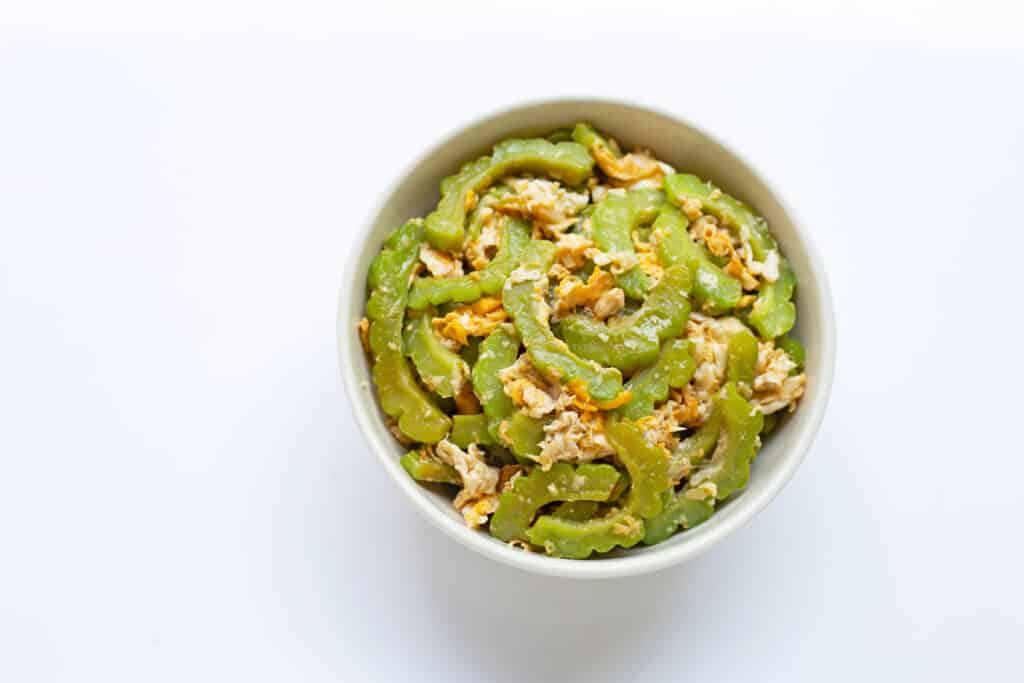
How to stir fry bitter melon
- Cut the bitter melon in half lengthwise.
- Remove the seeds with a metal spoon.
- Cut the halves into thin slices crosswise.
- Blanch the slices for 2 to 3 minutes in boiling water or sprinkle salt over the slices then place them in a colander to drain for 15 minutes. This will remove some of the bitter taste.
- Prepare seasonings such as chili pepper flakes, minced garlic, chopped onions or bell pepper.
- Heat a wok over medium-high heat and add 2 tablespoons of peanut oil.
- When the oil is hot, add the minced garlic and chili mixture.
- Stir-fry briefly until aromatic about 30 seconds.
- Add the bitter melon slices and stir-fry for about 2 minutes.
- Splash with balsamic vinegar and soy sauce.
- Stir in a 1/2 teaspoon of sugar.
- Cook until the bitter melon softens and starts to brown about 1 to 2 minutes.
- Stir in a few drops of soy sauce or sesame oil if desired.
To stir fry with eggs whisk two eggs with soy sauce, and pour the eggs over the bitter melon in Step 9 above about 1 minute after adding the bitter melon to the wok.
How to steam bitter melon
- Prepare halves and then slice crosswise.
- Place the bitter melon in a steamer basket in a large saucepan, cover, and let steam over gently boiling water until fork-tender, about 10 to 20 minutes depending on the size of the pieces.
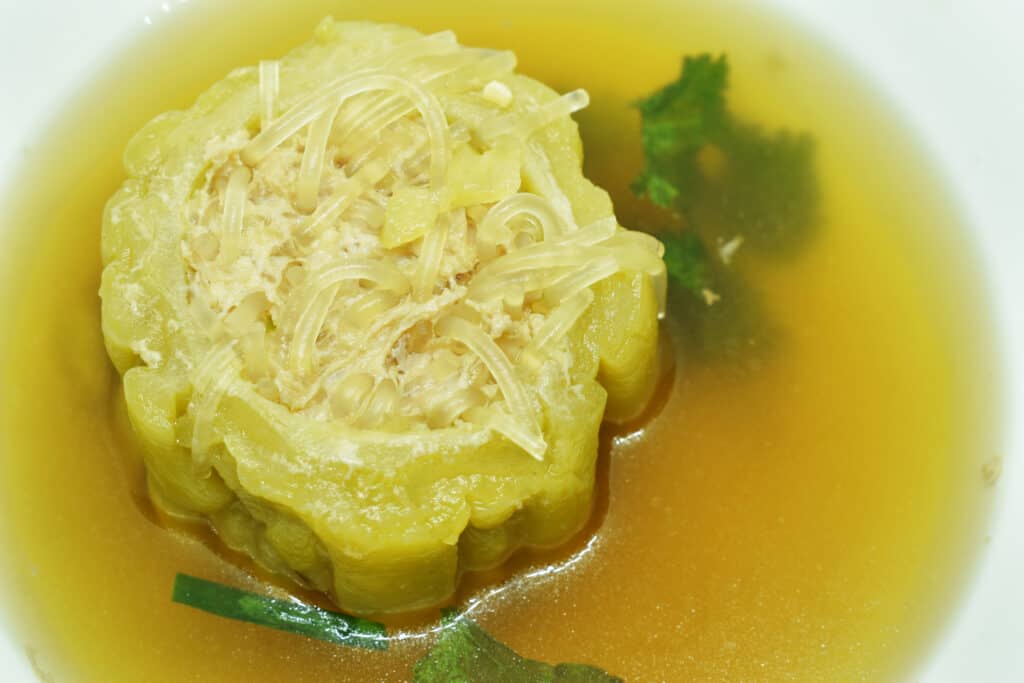
How to boil bitter melon
- Halve the bitter melon, remove the seeds, and then slice it crosswise or boil the halves.
- Place the bitter melon in a large pot and just cover with water.
- Cook over medium heat until tender, about 10 to 15 minutes.
Bitter melon flavor partners
- Balance the bitterness with intense flavors such as chili, garlic, tamarind, ginger, sweet soy, miso, fermented black beans, fish sauce, dried shrimp, and curry paste.
- Match the bitter melon with sweet vegetables like winter squash, sweet potatoes, and corn.
Bitter melon nutrition
- Bitter melon is a good source of iron and ascorbic acid and vitamin C.
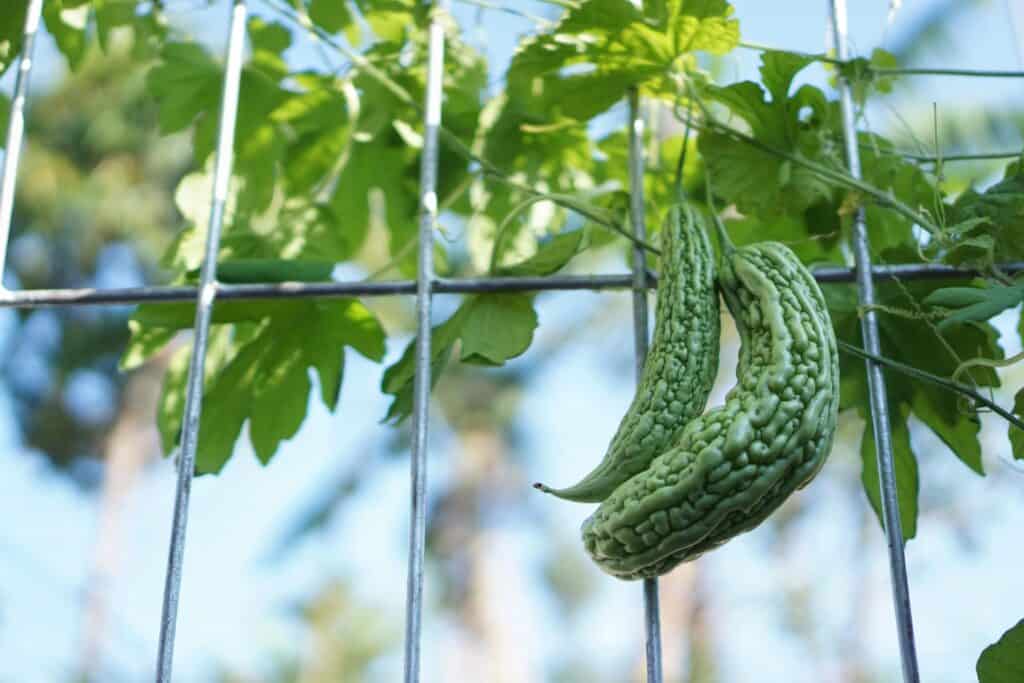
Get to know bitter melon
- Bitter melon is also called bitter gourd, bitter cucumber, or balsam pear. This fruit-vegetable is related to gourd, melon, and cucumber. Growing bitter melon requires all the same conditions required for growing cucumbers and melons.
- Bitter melons grow from 3 to 12 inches (7-30 cm) long on vines with tendrils that grow between 22 and 32 feet (6.7-9.7 m) long.
- The bitter melon is shaped like a cucumber with deeply and unevenly furrowed and warty skin. It is pale yellow early on, becomes greener as it matures, and ripens finally to a yellow-orange-red color becoming more bitter and acrid as it matures.
- The bitter melon has a thick, dry, pearly-colored flesh with numerous white seeds. The melon’s high quinine content gives it a bitter taste although some compare the taste of the bitter melon to the citrus pith and consider the flavor cool and cleansing.
- Bitter melons produce their first fruits about 2 months after sowing. The fruit follows a vanilla-scented flower. The first melons can be picked when they are as small as1-inch long. If left on the vine until fully ripe, the pulp will become blood-red and the fruit will split into three sections at the flower end.
- Bitter melons are native to tropical India and Africa and have been in cultivation for thousands of years. The bitter melon is most popular in the cookery of India, Indonesia, Southeast Asia, and China.
- Bitter melon is most popular in Asian cookery. There is a long-standing belief in Asia that anything bitter tasting is good for you and may even have healing power. In Western cookery, bitter melon is a bit of an acquired taste.
The botanical name of bitter melon is Momordica charantia.
Related articles:
Related articles:
How to Plant, Grow, and Harvest Chinese Cabbage
Five Ways to Cook and Serve Chinese Cabbage
Four Ways to Cook and Serve Napa Cabbage
Five Ways to Cook and Serve Bok Choy
How to Plant, Plant, Grow, and Harvest Mizuna
Ways to Prepare and Serve Mizuna
How to Cook and Serve Bitter Melon
Best Herbs for Container Growing
Garden Planning Books at Amazon:
- Vegetable Garden Almanac & Planner
- Kitchen Garden Grower’s Guide Vegetable Encyclopedia
- Vegetable Garden Grower’s Guide
- Tomato Grower’s Answer Book
More kitchen tips:
Bring your harvest to the table. Kitchen prep tips and easy recipes for the vegetables you grow. Click below for vegetable prep and recipes you can use now.
- Almonds
- Apples
- Apricot
- Aprium
- Artichoke
- Arugula
- Asparagus
- Avocado
- Bamboo Shoots
- Banana
- Basil
- Beans, Dried
- Beans. Long
- Beans, Shell
- Beans, Snap
- Beets
- Bitter Melon
- Blackberry
- Bok Choy
- Broccoli
- Broccoli Raab
- Brussels Sprouts
- Cabbage
- Cardoon
- Carrots
- Cauliflower
- Celeriac
- Celery
- Chard
- Chayote Squash
- Cherimoya
- Cherries
- Chestnut
- Chickpea
- Chinese Cabbage
- Chives
- Cilantro
- Citron
- Clementine
- Collards
- Coriander
- Corn, Sweet
- Corn, Baby
- Corn Salad, Mache
- Cranberry
- Cress
- Cucumber
- Daikon
- Dandelion
- Dill
- Eggplant
- Endive, Belgian
- Endive and Escarole
- Fava Beans
- Fig
- Florence Fennel
- Garlic
- Ginger
- Grapefruit
- Grapes
- Guava
- Horseradish
- Jerusalem Artichoke
- Jicama
- Jujube
- Kale
- Kiwifruit
- Kohlrabi
- Kumquat
- Leeks
- Lemongrass
- Lemons
- Lettuce
- Lime
- Mache (Corn Salad)
- Mandarin Orange
- Mango
- Maple Syrup
- Marjoram
- Melons
- Michihili
- Mint
- Mizuna
- Mushrooms
- Mushrooms, Cremini
- Mustard Greens
- Napa Cabbage
- Nectarine
- Okra
- Olives
- Olive oil
- Onions
- Oranges
- Oregano
- Parsley
- Parsley Root
- Parsnips
- Passion Fruit
- Pawpaw
- Peaches
- Pears
- Peas, Garden Snap
- Peas, Snow
- Pei Tsai
- Peppers, Chili
- Peppers, Sweet
- Persimmon
- Pineapple
- Pineapple Guava
- Plantain
- Plums
- Pluots
- Pomegranate
- Potatoes
- Prickly Pear
- Pumpkin
- Quince
- Radicchio
- Radishes
- Raspberries
- Rosemary
- Rhubarb
- Rutabaga
- Sage
- Salsify
- Sauerkraut
- Savory
- Shallots
- Sorrel
- Spinach
- Squash, Summer
- Squash, Winter
- Strawberries
- Sunchokes
- Sunflower
- Sweet Potato
- Swiss Chard
- Tangerine
- Taro
- Tarragon
- Thyme
- Tomatillo
- Tomato
- Turnip
- Turnip Greens
- Yams


